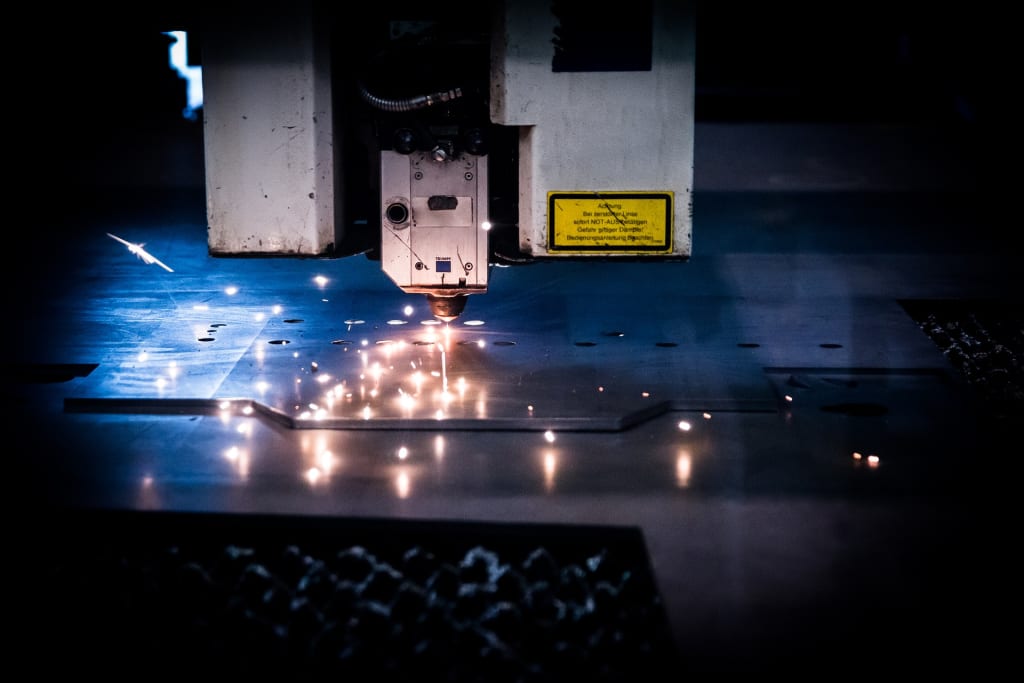
Sheetmetal Laser cutting explained
The mighty power beam called Laser!
Lasers are used for many purposes. One way they are used is for cutting plates. On mild steel, stainless steel and Aluminum plates. The laser cutting procedure is highly precise, yields excellent good quality, has a very small kerf width and little heat impact zone, and makes it possible to cut very intricate shapes and tiny holes.
How it works ?
The high power density results in quick heating, melting and partial or entire vaporising of the substance. When cutting mild steel, the warmth of the laser beam is enough to start a standard"oxy-fuel" burning procedure, and the laser cutting off gasoline is going to probably be pure oxygen, just like an oxy-fuel flashlight. When trimming stainless steel or Aluminum, then the laser beam only melts the substance, and high pressure nitrogen is utilized to blow the molten metal out of the kerf.
Many folks know that the term"LASER" is an acronym for Light Amplification by Stimulated Emission of Radiation. But how does light cut through a metal plate?
The laser beam is formed in to a column of very significant intensity lighting, of a single wavelength, or color. In the instance of a typical CO2 laser, that wavelength is at the Infra-Red part of the light spectrum, so it is invisible to the human eye. The beam is only about 3/4 of an inch in diameter as it moves from your laser resonator, which creates the ray, throughout the system's beam path. The concentrated laser beam extends through the bore of a nozzle before it hits the plate.
On a CNC laser cutter, the laser cutting head has been transferred over the metallic plate in the shape of the desired part, thus cutting on the part out of the plate. A capacitive height control system maintains an extremely precise distance between the close of the nozzle and the plate that's being cut. This distance is important, since it determines where the focal point is relative to the surface of the plate. Cut quality can be impacted by lifting or lowering the focal point from just above the surface of the plate, at the top, or just beneath the surface.
There are many, many different parameters that impact high-quality too, but when are controlled properly, laser cutting is a secure, trustworthy, and very accurate cutting procedure.
Focusing the laser beam may be accomplished by a distinctive lens, or by a curved mirror, and this occurs in the laser cutting head. The beam has to be precisely focused so that the shape of the focus spot and the density of their energy in that spot are perfectly consistent and round, and centered in the nozzle. By focusing on the massive beam down to one pinpoint, the warmth density in that place is extreme. Consider having a magnifying glass to focus the sun's rays onto a leaf, and how that can begin a fire. Now think about focusing 6 KWatts of energy into a single place, and you may imagine how hot that place will get!
The Laser cutting service is utilised mainly in Metal Fabrication industries like best Sheet Metal Fabrication company in Melbourne like Aston Precision in Dandenong Australia.
Design and Realization
Before a piece of sheet metal can be shaped and included in a blueprint or construction, it needs to be designed to fit specifications. Like many other products, sheet metal starts out on the drawing board. An engineer must draw up a sketch and then create a design that will fit the needs of the client or facility that requires the metal.
Quality workmanship is required to bring quality sheet metal from the drawing board to the end of the production line. Starting off with a good design allows the later parts of manufacture to successfully produce adequate sheet metal. Facilities need to employ high-quality designers so that their sheet metal pieces are up to par. Best companies in sheet metal manufacturing, utilize expert design teams to provide quality designs and prototypes for their sheet metal fabrication. It's a crucial part of the production process that determines how well the sheet metal will turn out.
Safety Precautions
The manufacturing process for sheet metal often includes working with high temperatures and powerful machinery. Employees working on the floor of the facility are exposed to hazardous working conditions, which is why safety precautions must be taken to ensure that they avoid injury.
Everything from production to the transport of sheet metal can be hazardous. The spinning process that helps give the sheet metal its shape can easily cause injury if employees are not careful. Special tools are required to push the metal between the spindles that shape the sheets. At the same time, employees must stick to safety guidelines to avoid coming into contact with hazardous materials and machinery. Safety gear is also a requirement for avoiding unnecessary injury when working with moving parts.
Conclusion
There are various different ways to shape and utilize sheet metal to fit manufacture needs. The process of creating sheet metal isn’t particularly complex, but it still requires the input and expertise of experienced personnel from start to finish. With the right tools, this process can go along smoothly and create high-quality pieces of sheet metal for the facility and its clients.





Comments
There are no comments for this story
Be the first to respond and start the conversation.